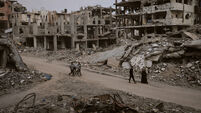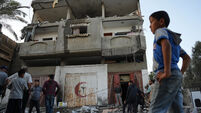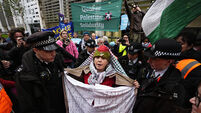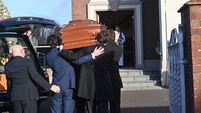Peter Power: Gaza was suffering a humanitarian catastrophe before a bomb was even dropped
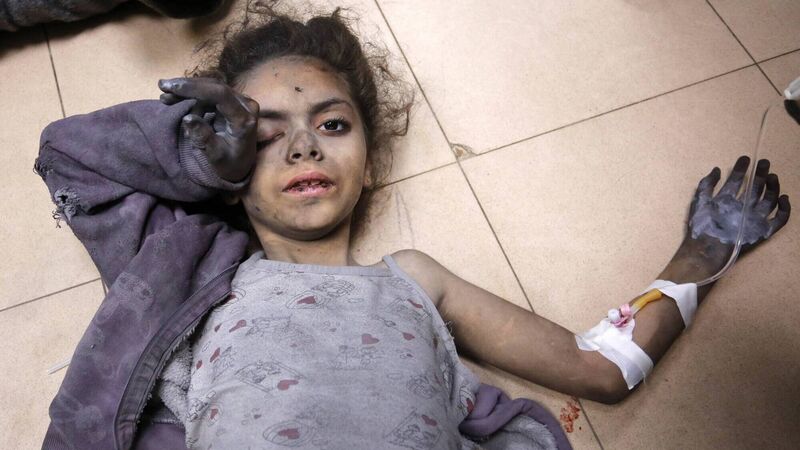
An injured Palestinian girl undergoes treatment at a hospital after Israeli attacks. Picture: Getty Images
When I visited Gaza in August, just six weeks before the war, it took my breath away.
Having spent time working in many of Unicef's programme countries across Africa, South America, and the Middle East, I have witnessed the truly devastating impact of both manmade and climate emergencies on the lives of vulnerable children. The complexity and intensity of need across the Gaza Strip was unlike anything I had ever seen.
In June 2023, four months before the outbreak of war in Gaza, Unicef published its mid-year Humanitarian Situation Report for the State of Palestine, detailing the humanitarian status of the region during the first six months of the year.
The report found that 2.1 million people, including 930,000 children, were in need of humanitarian assistance, the majority of whom resided in the Gaza Strip; and this was before a bomb was dropped on Gaza.
Locally referred to as an “open-air prison”, Gaza’s population of 2.2 million remained cut off from the rest of the world, squashed into a region about the size of Louth, heavily reliant on Israel and humanitarian organisations to provide basic products and services like food, clean water, healthcare, electricity, and education.
It is hugely challenging to find the words to accurately describe the rapid decline of a situation when the starting point was already a humanitarian catastrophe.
We have all seen the soul-destroying imagery and footage that has emerged from Gaza over the last four months. Beginning with the appalling atrocities by Hamas on October 7 to the devastating bombing campaign, children have been affected the most.
Swirling dust and piles of rubble as far as the eye can see, mothers and fathers weeping over the bodies of their dead children, communities rallying in the face of relentless bombardment, using whatever they can to transport the injured to the closest hospital and praying that it’s still somewhat functioning, boys and girls who should be playing with friends crying out in pain as exhausted doctors try to preserve what they can of their war-wounded bodies.
What these snapshots of incomprehensible horror cannot capture is the scale and longevity of suffering and injustice their subjects have borne all their lives.
A child of 15 in Gaza has already lived through five wars and endured more pain than most of us will in our lifetime. For five wars, the children of Gaza have gone to bed hoping they will wake up in the morning, that their families and friends will still be there, and that their homes will remain intact.
The loss-pain-anxiety cycle is something they have carried with them every day, manifesting in a phobia of loud noises, a wave of panic when a door is slammed or a pot dropped on the kitchen floor, bedwetting into their teens, and stunted development as their fear leaves them rooted to their parents’ sides.
After four months of the most deadly escalation of violence in the region since 1948, the humanitarian situation in Gaza has leaped far beyond unsustainable. More than 26,000 people are reported dead, about two-thirds of whom are expected to be women and children. 65,000 people are reported injured, many of whom are fighting for their lives in the seven remaining —partially functioning — hospitals of which there were 36 before the war.
Over one million children are displaced; their homes are a distant memory as they crowd into heaving shelters or try to stay safe in an ever-shrinking patch of land in the south of the strip. Poised on the cusp of famine, human waste flows through the streets as parents weigh the risk of dehydration against the spread of disease through dirty water. Cases of diarrhoea, the second highest killer of children under five in the world, have increased by 2000% since October 7.
The fabric of Gazan society is quickly unravelling to the point of irreparable damage. While both parties consider proposals for a ceasefire, our first wish for children, both the children of Gaza and of Israel, is a permanent end to the violence that has stained their childhood forever.
Our second wish is for the world to stand with us as we sift through the rubble and support the children and people of Gaza to rebuild their lives from a foundation of peace.
Unicef's mission is to be there for children before, during, and after emergencies. It is our experience that the after is often where the toughest work begins. In the case of Gaza, where the level of trauma and humanitarian need was already so high before the war, there is no precedent for how long this will take.
The support for Gaza from the Irish people has been commendable. Unicef has been the frontrunner in fundraising and advocacy which has manifested in the almost 400 trucks of life-saving water, therapeutic food, vaccines, health and sanitation supplies, and winterisation materials we have delivered since the Rafah Crossing first opened on October 21.
What we would ask at this point is that when the images slip from the headlines, when the loss, injustice, and destruction surpass the boundaries of language and comprehension, and when other nations reduce their support, that we as a people remain committed in our unique and enduring connection to the people of Gaza, and refuse to forget them when they need us the most.



